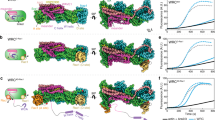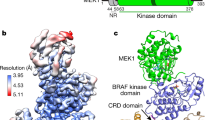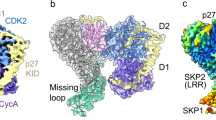Abstract
The proteins Cdc42 and Rac are members of the Rho family of small GTPases (G proteins), which control signal-transduction pathways that lead to rearrangements of the cell cytoskeleton, cell differentiation and cell proliferation. They do so by binding to downstream effector proteins1. Some of these, known as CRIB (for Cdc42/Rac interactive-binding) proteins2, bind to both Cdc42 and Rac, such as the PAK1–3 serine/threonine kinases3, whereas others are specific for Cdc42, such as the ACK tyrosine kinases4,5 and the Wiscott–Aldrich-syndrome proteins (WASPs)6,7. The effector loop of Cdc42 and Rac (comprising residues 30–40, also called switch I), is one of two regions which change conformation on exchange of GDP for GTP. This region is almost identical in Cdc42 and Racs, indicating that it does not determine the specificity of these G proteins. Here we report the solution structure of the complex of Cdc42 with the GTPase-binding domain of ACK4,5. Both proteins undergo significant conformational changes on binding, to form a new type of G-protein/effector complex. The interaction extends the β-sheet in Cdc42 by binding an extended strand from ACK, as seen in Ras/effector interactions8,9, but it also involves other regions of the G protein that are important for determining the specificity of effector binding.
This is a preview of subscription content, access via your institution
Access options
Subscribe to this journal
Receive 51 print issues and online access
$199.00 per year
only $3.90 per issue
Buy this article
- Purchase on Springer Link
- Instant access to full article PDF
Prices may be subject to local taxes which are calculated during checkout



Similar content being viewed by others
References
Tapon, N. & Hall, A. Rho, Rac and Cdc42 GTPases regulate the organization of the actin cytoskeleton. Curr. Opin. Cell Biol. 9, 86–92 (1997).
Burbelo, P. D., Drechsel, D. & Hall, A. Aconserved binding motif defines numerous candidate target proteins for both Cdc42 and Rac GTPases. J. Biol. Chem. 270, 29071–29074 (1995).
Sells, M. A. & Chernoff, J. Emerging from the PAK: the p21-activated protein kinase family. Trends Cell Biol. 7, 162–167 (1997).
Manser, E., Leung, T., Salihuddin, H., Tan, L. & Lim, L. Anon-receptor tyrosine kinase that inhibits the GTPase activity of p21cdc42. Nature 363, 364–367 (1993).
Yang, W. & Cerione, R. A. Cloning and characterization of a novel Cdc42-associated tyrosine kinase, ACK-2, from bovine brain. J. Biol. Chem. 222, 24819–24824 (1997).
Symons, M.et al. Wiskott-Aldrich syndrome protein, a novel effector for the GTPase Cdc42Hs, is implicated in actin polymerization. Cell 84, 723–734 (1996).
Aspenström, P., Lindberg, U. & Hall, A. Two GTPases, Cdc42 and Rac, bind directly to a protein implicated in the immunodeficiency disorder Wiskott-Aldrich syndrome. Curr. Biol. 6, 70–75 (1996).
Nassar, N.et al. The 2.2 å crystal structure of the Ras-binding domain of the serine/threonine kinase c-Raf1 in complex with Rap1a and a GTP analogue. Nature 375, 554–560 (1995).
Huang, L., Hofer, F., Martin, G. S. & Kim, S.-H. Structural basis for the interaction of Ras with RalGDS. Nature Struct. Biol. 5, 422–426 (1998).
Rudolph, M. G.et al. The Cdc42/Rac interactive binding region motif of the Wiscott Aldrich Syndrome Protein (WASP) is necessary but not sufficient for tight binding to Cdc42 and structure formation. J. Biol. Chem. 273, 18067–18076 (1998).
Hirshberg, M., Stockley, R. W., Dodson, G. & Webb, M. R. The crystal structure of human Rac1, a member of the Rho-family complexed with a GTP analogue. Nature Struct. Biol. 4, 147–152 (1997).
Feltham, J. L.et al. Definition of the switch surface in the solution structure of CDC42Hs. Biochemistry 36, 8755–8766 (1997).
Ostermeier, C. & Brünger, A. T. Structural basis of Rab effector specificity; Crystal structure of the small G protein Rab3A complexed with the effector domain of Rabphilin-3A. Cell 96, 363–374 (1999).
Vetter, I. R., Nowak, C., Nishimoto, T., Kuhlman, J. & Wittinghofer, A. Structure of a Ran-binding domain complexed with Ran bound to a GTP analogue: implications for nuclear transport. Nature 398, 39–46 (1999).
Leonard, D. A.et al. Use of fluorescence spectroscopic readout to characterise the interactions of Cdc42Hs with its target/effector, mPAK3. Biochemistry 36, 1173–1180 (1997).
Miki, H., Sasaki, T., Takai, Y. & Takenawa, T. Induction of filopodium formation by a WASP-related actin-depolymerizing protein N-WASP. Nature 391, 93–96 (1998).
Rittinger, K.et al. Crystal structure of a small G protein in complex with the GTPase-activating protein rhoGAP. Nature 388, 693–697 (1997).
Khosravi-Far, R., Campbell, S., Rossman, K. L. & Der, C. J. Increasing complexity of Ras signal transduction: involvement of Rho family proteins. Adv. Cancer Res. 72, 57–107 (1998).
Diekmann, D., Nobes, C. D., Burbelo, P. D., Abo, A. & Hall, A. Rac GTPase interacts with GAPs and target proteins through multiple effector sites. EMBO J. 14, 5297–5305 (1995).
Nisimoto, Y., Freeman, J. L. R., Motalebi, S. A., Hirshberg, M. & Lambeth, J. D. Rac binding to p67phox. J. Biol. Chem. 272, 18834–18841 (1997).
Toporik, A., Gorzalczany, Y., Hirshberg, M., Pick, E. & Lotan, O. Mutational analysis of novel effector domains in Rac1 involved in the activation of nicotinamide adenine dinucleotide phosphate (reduced) oxidase. Biochemistry 37, 7147–7156 (1998).
Thompson, G., Owen, D., Chalk, P. A. & Lowe, P. N. Delineation of the Cdc42/RAC-binding domain of p21-activated kinase. Biochemistry 21, 7885–7891 (1998).
Guo, W., Sutcliffe, M. J., Cerione, R. A. & Oswald, R. E. Identification of the binding surface on Cdc42Hs for p21-activated kinase. Biochemistry 37, 14030–14037 (1998).
Abdul-Manan, N.et al. Structure of Cdc42 in complex with the GTPase-binding domain of the ‘Wiscott–Aldrich syndrome’ protein. Nature 399, 379–383 (1999).
Brünger, A. T. XPLOR: A System for X-ray Crystallography and NMR (Yale University, (1992).
Zwahlen, C.et al. Methods for measurement of intermolecular NOEs by multinuclear NMR spectroscopy: application to a bacteriophase λ N-peptide/box RNA complex. J. Am. Chem. Soc. 119, 6711–6721 (1997).
Nilges, M., Macias, M. J., O'Donoghue, S. I. & Oschkinat, H. Automated NOESY interpretation with ambiguous restraints: The refined NMR solution structure of the pleckstrin homology domain from β-spectrin. J. Mol. Biol. 269, 408–422 (1997).
Barton, G. J. ALSCRIPT a tool to format multiple sequence alignments. Prot. Eng. 6, 37–40 (1993).
Kraulis, P. J. MOLSCRIPT: a program to produce both detailed and schematic plots of protein structures. J. appl. Crystallogr. 24, 946–950 (1991).
Merrit, E. A. & Murphy, M. E. Raster3D. A program for photorealistic molecular graphics. Acta Crystallogr. D 50, 869–873 (1994).
Acknowledgements
We thank M. Rudolph and A. Wittinghofer for the expression clone of the WASP Cdc42-binding domain; M. Nilges for X-PLOR scripts; M. Hirshberg for helpful comments on the manuscript; the MRC for a training fellowship (to H.R.M.) and the European Commission for financial support. The Cambridge Centre for Molecular Recognition is supported by the BBSRC and the Wellcome Trust.
Author information
Authors and Affiliations
Corresponding author
Rights and permissions
About this article
Cite this article
Mott, H., Owen, D., Nietlispach, D. et al. Structure of the small G protein Cdc42 bound to the GTPase-binding domain of ACK. Nature 399, 384–388 (1999). https://doi.org/10.1038/20732
Received:
Accepted:
Issue Date:
DOI: https://doi.org/10.1038/20732
This article is cited by
-
NMR resonance assignments for the active and inactive conformations of the small G protein RalA
Biomolecular NMR Assignments (2020)
-
Some (dis)assembly required: partial unfolding in the Par-6 allosteric switch
Biophysical Reviews (2015)
-
Mechanism of IRSp53 inhibition and combinatorial activation by Cdc42 and downstream effectors
Nature Structural & Molecular Biology (2014)
-
A role for the tyrosine kinase ACK1 in neurotrophin signaling and neuronal extension and branching
Cell Death & Disease (2013)
-
Crystal structure of Rac1 bound to its effector phospholipase C-β2
Nature Structural & Molecular Biology (2006)
Comments
By submitting a comment you agree to abide by our Terms and Community Guidelines. If you find something abusive or that does not comply with our terms or guidelines please flag it as inappropriate.



